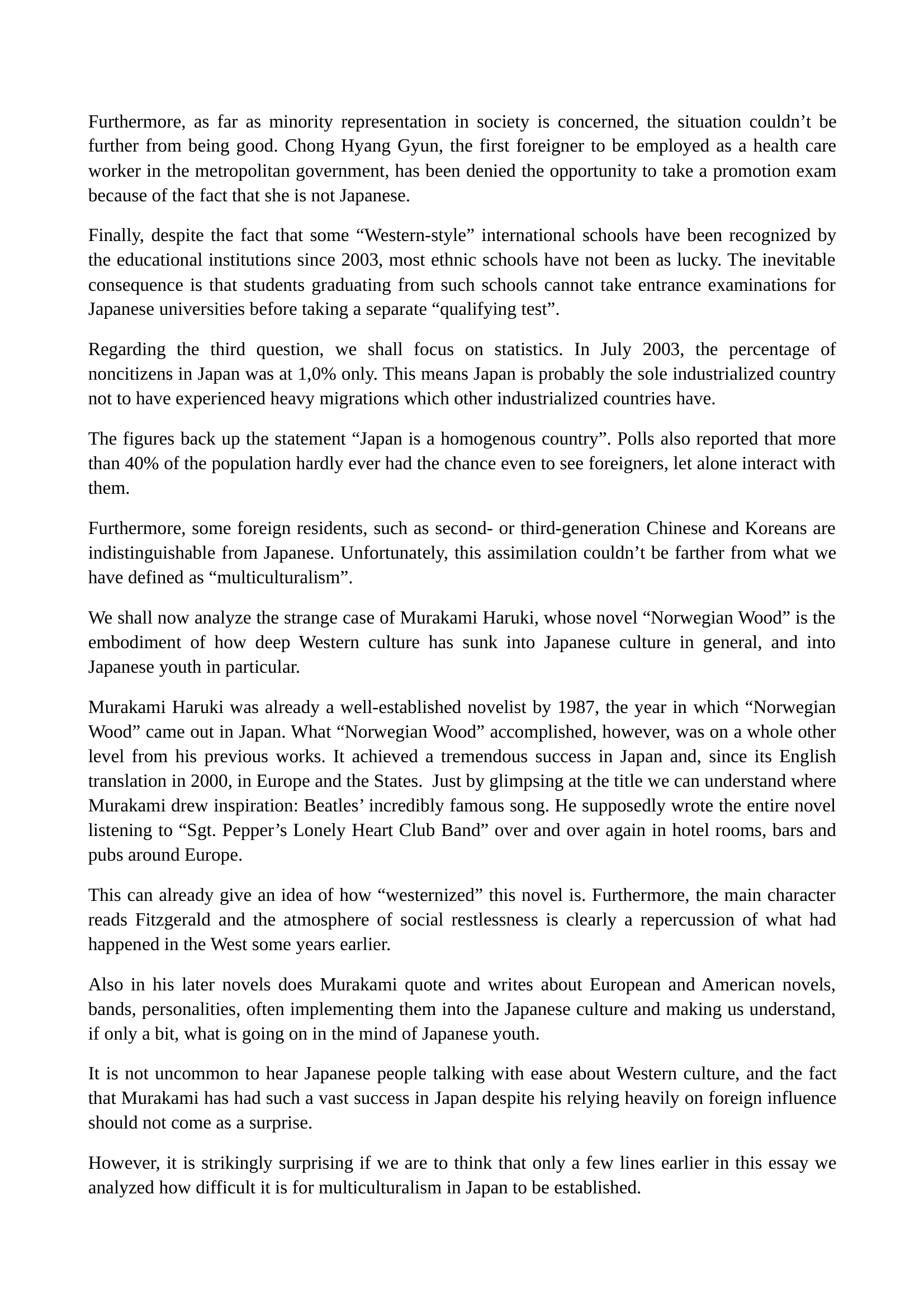Multicultural Japan
Publié le 25/12/2012
Extrait du document
«
Furthermore, as far as minority representation in society is concerned, the situation couldn’t be
further from being good.
Chong Hyang Gyun, the first foreigner to be employed as a health care
worker in the metropolitan government, has been denied the opportunity to take a promotion exam
because of the fact that she is not Japanese.
Finally, despite the fact that some “Western-style” international schools have been recognized by
the educational institutions since 2003, most ethnic schools have not been as lucky.
The inevitable
consequence is that students graduating from such schools cannot take entrance examinations for
Japanese universities before taking a separate “qualifying test”.
Regarding the third question, we shall focus on statistics.
In July 2003, the percentage of
noncitizens in Japan was at 1,0% only.
This means Japan is probably the sole industrialized country
not to have experienced heavy migrations which other industrialized countries have.
The figures back up the statement “Japan is a homogenous country”.
Polls also reported that more
than 40% of the population hardly ever had the chance even to see foreigners, let alone interact with
them.
Furthermore, some foreign residents, such as second- or third-generation Chinese and Koreans are
indistinguishable from Japanese.
Unfortunately, this assimilation couldn’t be farther from what we
have defined as “multiculturalism”.
We shall now analyze the strange case of Murakami Haruki, whose novel “Norwegian Wood” is the
embodiment of how deep Western culture has sunk into Japanese culture in general, and into
Japanese youth in particular.
Murakami Haruki was already a well-established novelist by 1987, the year in which “Norwegian
Wood” came out in Japan.
What “Norwegian Wood” accomplished, however, was on a whole other
level from his previous works.
It achieved a tremendous success in Japan and, since its English
translation in 2000, in Europe and the States.
Just by glimpsing at the title we can understand where
Murakami drew inspiration: Beatles’ incredibly famous song.
He supposedly wrote the entire novel
listening to “Sgt.
Pepper’s Lonely Heart Club Band” over and over again in hotel rooms, bars and
pubs around Europe.
This can already give an idea of how “westernized” this novel is.
Furthermore, the main character
reads Fitzgerald and the atmosphere of social restlessness is clearly a repercussion of what had
happened in the West some years earlier.
Also in his later novels does Murakami quote and writes about European and American novels,
bands, personalities, often implementing them into the Japanese culture and making us understand,
if only a bit, what is going on in the mind of Japanese youth.
It is not uncommon to hear Japanese people talking with ease about Western culture, and the fact
that Murakami has had such a vast success in Japan despite his relying heavily on foreign influence
should not come as a surprise.
However, it is strikingly surprising if we are to think that only a few lines earlier in this essay we
analyzed how difficult it is for multiculturalism in Japan to be established..
»
↓↓↓ APERÇU DU DOCUMENT ↓↓↓
Liens utiles
- multicultural britain: Is there such thing as a British identity?
- cool japan
- ESPANA MULTICULTURAL
- Kokusaiho Gakkwai ou L'asotiation international du droit de Japan - text
- Japan - geographie.


